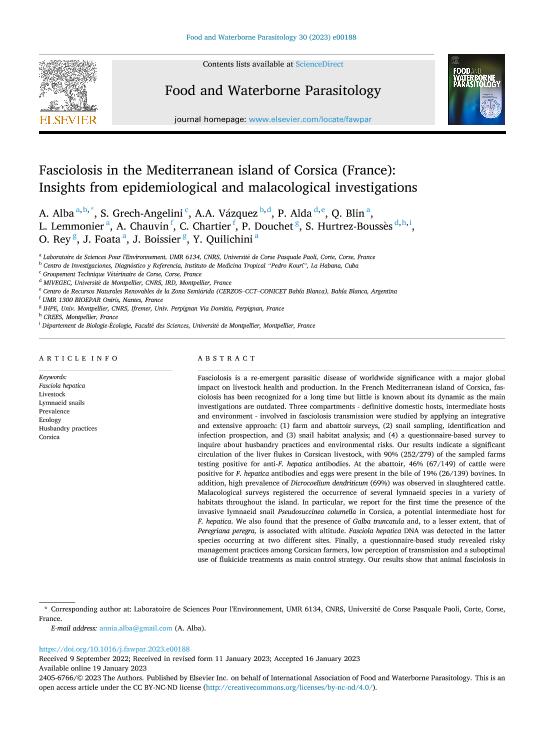Artículo
Fasciolosis in the Mediterranean island of Corsica (France): Insights from epidemiological and malacological investigations
Alba, A.; Grech Angelini, S.; Vázquez, A.A.; Alda, Maria del Pilar ; Blin, Q.; Lemmonier, L.; Chauvin, A.; Chartier, C.; Douchet, P.; Hurtrez Boussès, S.; Rey, O.; Foata, J.; Boissier, J.; Quilichini, Y.
; Blin, Q.; Lemmonier, L.; Chauvin, A.; Chartier, C.; Douchet, P.; Hurtrez Boussès, S.; Rey, O.; Foata, J.; Boissier, J.; Quilichini, Y.
 ; Blin, Q.; Lemmonier, L.; Chauvin, A.; Chartier, C.; Douchet, P.; Hurtrez Boussès, S.; Rey, O.; Foata, J.; Boissier, J.; Quilichini, Y.
; Blin, Q.; Lemmonier, L.; Chauvin, A.; Chartier, C.; Douchet, P.; Hurtrez Boussès, S.; Rey, O.; Foata, J.; Boissier, J.; Quilichini, Y.
Fecha de publicación:
03/2023
Editorial:
Elsevier
Revista:
Food and Waterborne Parasitology
ISSN:
2405-6766
Idioma:
Inglés
Tipo de recurso:
Artículo publicado
Clasificación temática:
Resumen
Fasciolosis is a re-emergent parasitic disease of worldwide significance with a major global impact on livestock health and production. In the French Mediterranean island of Corsica, fasciolosis has been recognized for a long time but little is known about its dynamic as the main investigations are outdated. Three compartments - definitive domestic hosts, intermediate hosts and environment - involved in fasciolosis transmission were studied by applying an integrative and extensive approach: (1) farm and abattoir surveys, (2) snail sampling, identification and infection prospection, and (3) snail habitat analysis; and (4) a questionnaire-based survey to inquire about husbandry practices and environmental risks. Our results indicate a significant circulation of the liver flukes in Corsican livestock, with 90% (252/279) of the sampled farms testing positive for anti-F. hepatica antibodies. At the abattoir, 46% (67/149) of cattle were positive for F. hepatica antibodies and eggs were present in the bile of 19% (26/139) bovines. In addition, high prevalence of Dicrocoelium dendriticum (69%) was observed in slaughtered cattle. Malacological surveys registered the occurrence of several lymnaeid species in a variety of habitats throughout the island. In particular, we report for the first time the presence of the invasive lymnaeid snail Pseudosuccinea columella in Corsica, a potential intermediate host for F. hepatica. We also found that the presence of Galba truncatula and, to a lesser extent, that of Peregriana peregra, is associated with altitude. Fasciola hepatica DNA was detected in the latter species occurring at two different sites. Finally, a questionnaire-based study revealed risky management practices among Corsican farmers, low perception of transmission and a suboptimal use of flukicide treatments as main control strategy. Our results show that animal fasciolosis in Corsica is characterised by a significant circulation and a favourable epidemiological scenario for transmission to occur.
Archivos asociados
Licencia
Identificadores
Colecciones
Articulos(CERZOS)
Articulos de CENTRO REC.NAT.RENOVABLES DE ZONA SEMIARIDA(I)
Articulos de CENTRO REC.NAT.RENOVABLES DE ZONA SEMIARIDA(I)
Citación
Alba, A.; Grech Angelini, S.; Vázquez, A.A.; Alda, Maria del Pilar; Blin, Q.; et al.; Fasciolosis in the Mediterranean island of Corsica (France): Insights from epidemiological and malacological investigations; Elsevier; Food and Waterborne Parasitology; 30; 3-2023; 1-17
Compartir
Altmétricas



